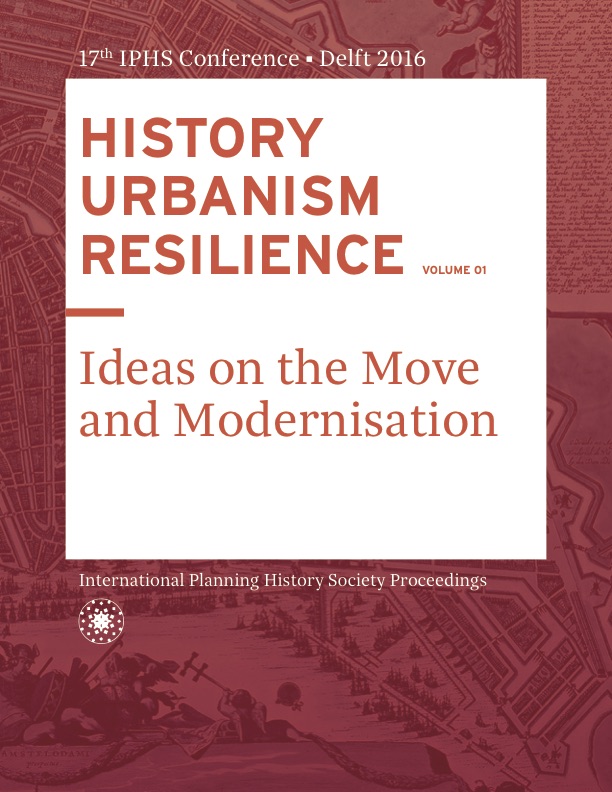The paradox of Gordon Cullen: between international celebrity and a limited career abroad
DOI:
https://doi.org/10.7480/iphs.2016.1.1209Abstract
The British draughtsman, journalist and “townscape consultant” Gordon Cullen had a paradoxical position in the postwar international planning scene. He acquired early international celebrity thanks to his editorial work but he never managed to establish a broad international professional practice even if he was at first recruited for consultancy abroad.Gordon Cullen became known after publishing articles in the professional journal The Architectural Review between 1947 and 1959 that belonged to the “Townscape” editorial campaign. In 1961, he published the book entitled Townscape collecting these articles with a theoretical first part, which has been translated in eight languages until today. In 1959, he came by boat to join the planning team funded by the Ford Foundation and assembled by the American planner Albert Mayer to help the Indian technicians to develop a new master plan for New Delhi. Recruited as civic designer, he proposed in his own report entitled The Ninth Delhi an impressive transformation of the city core in a new townscape. This commission was quickly followed by another one again for the Ford Foundation to work on the planning of Calcutta. Between these two studies, he was also commissioned jointly with Ian Nairn, his fellow “townscapist” at The Architectural Review, by Ian McHarg and the University of Pennsylvania for a research on “The American Townscape” granted by the Rockefeller Foundation. This commission was chaotic: his visit of six East coast cities in 1960 ended in the production of a manuscript that was never published.
After these first commissions, his long career of consultant remained almost entirely within Britain, working alone or within teams for the Camden Borough Council, the Cities of Liverpool, Bolton, Northampton and Peterborough, the Kent County Planning Council, the Buckinghamshire Departments of Architecture and Planning, etc. before ending his career with commissions for the London Docklands Development Corporation and the Scottish Development Agency. Nevertheless, he worked also on some small commissions abroad like a study for St Quentin en Yvelines New Town near Paris for Kinneir Calvert Tuhill or a study of the Argentinean Northwest touristic villages for the Organization of American States. More importantly, he organized during several years a summer school in the small village of Biot on the French Riviera which attracted an international audience of students.
The reasons of his paradoxical position are complex. His introverted character and, moreover, his inability to travel by airplane explain partly his limited career abroad. However, during the same period, other key theorists without the same limitations, such as the American Kevin Lynch, never developed an international consulting activity. They exemplify a disruption between theory and practice in the postwar international scene that may be linked to the contrast between practice, which remained idiosyncratic, and theory, which could quickly be spread around the world thanks to the growing international diffusion of publications.
References
Aitchinson, Mathew, “Townscape: Scope, Scale and Extent,” The Journal of Architecture 17:5 (2012), 621-642.
Battro, Antonio, “De Biot a Pumamarca: la exploracion del espacio y de la escala humana” in Sylvia Rickert and Jorge Bozzano, Eduardo Ellis: Espacio arquitectonico y escala humana, Buenos Aires: Ciudad de Buenos Aires, 2014.
Burke, Gilbert, “Britain: ‘The Crust is Cracking’,” Fortune 55:6 (1957), 123-130ff.
CMPO, “Towards a New Calcutta,” Annual of Architecture, Structure and Town Planning, 4 (1963), E2-E16.
Cullen, Gordon, The Ninth Delhi, New Delhi: TPO, 1961.
Cullen, Gordon, “The XIth Delhi,” The Architectural Review 127:756 (1960), 110-117.
Cullen, Gordon, Townscape, London: The Architectural Press, 1961.
Cullen, Gordon, Civic Design Studies, Calcutta: CMPO, 1962.
Cullen, Gordon, “Calcutta, the Linear City,” Annual of Architecture, Structure and Town Planning, 5 (1964-65), B1-B10.
Dasgupta, B., Bhattacharya, M., Basu, D. K., Chatterjee, M., Banerjee, T. K. (eds.), Calcutta’s Urban Future: Agonies from the Past and Prospects for the Future, Calcutta: Government of West Bengal, 1991.
Erten, Erdem, Shaping “The Second Half Century” : the Architectural Review, 1947-1971, PhD dissertation, The Massachusetts Institute of technology, 2004.
Jackson, Iain, “Tropical Architecture and the West Indies: From Military Advances and Tropical Medicine, to Robert Gardner-Medwin and the Networks of Tropical Modernism,” The Journal of Architecture, 18:2 (2013), 167-195.
Jacobs, Jane, “Downtown is for People,” Fortune 57:4 (1958), 113–40ff.
Gosling, David, Gordon Cullen: Visions of Urban Design, London: Academy Edition, 1996.
Kanvinde, Achyut P. (ed.), Seminar on Architecture, New Delhi: Lalit Kala Akademi, 1959.
Laurence, Peter L., “Jane Jacobs, the Townscape Movement, and the Emergence of Critical Urban Design,” in Pendlebury, John, Ertem, Erdem and J. Larkham, Peter (eds.), Alternative Visions of Post-War Reconstruction: Creating the Modern Townscape, London: Routledge, 2015, 216-226.
Meats, Antony and Cullen, Gordon, Programa de desarollo turistico del NOA: Estudio del paisaje urbano en los pueblos del noroeste, Washington DC: Secretaria general de la Organizacion de los Estados Americanos, 1974.
Nairn, Ian, The American Landscape: A Critical View, New York: Random House, 1965.
Orillard, Clément, “Tracing Urban Design’s ‘Townscape’ Origins. Some Relationships Between a British Editorial Policy and an American Academic Field,” Urban History 36:2 (2009), 284-302.
Orillard, Clément, “Gordon Cullen beyond The Architectural Review. Some New Perspectives from his Personal Archives,” The Journal of Architecture 17:5 (2012), 721-733.
Orillard, Clément, “The Transnational Building of Urban Design: Interplay Between Genres of Discourse in the Anglophone World,” Planning Perspectives 29:2 (2014), 209-229.
Orillard, Clément, “Gordon Cullen and his Changing Practice,” paper delivered at the Gordon Cullen Centenary Seminar, University of Westminster, November 29, 2014.
Powers, Alan, “Townscape as a Model of Organised Complexity,” The Journal of Architecture 17:5 (2012), 691-702.
Raynsford, Anthony, “Urban Contrast and Neo-Toryism: on the Social and Political Symbolism of The Architectural Review’s Townscape Campaign,” Planning Perspectives 30:1 (2015), 95-128.
Sundaram, Ravi, Pirate Modernity: Delhi’s Media Urbanism, London: Routledge, 2010.

